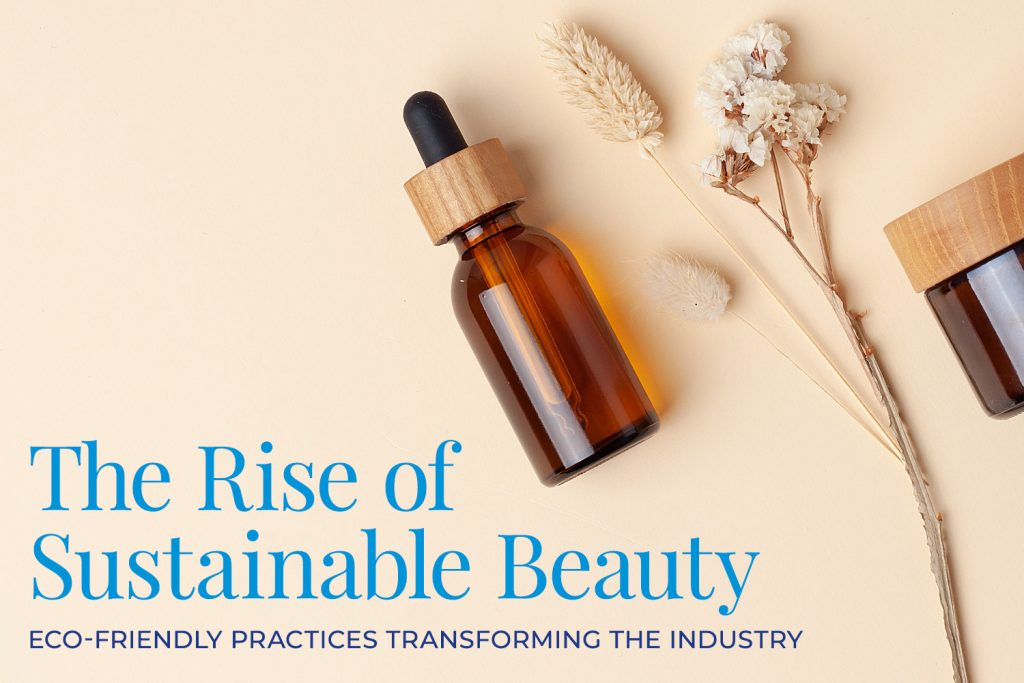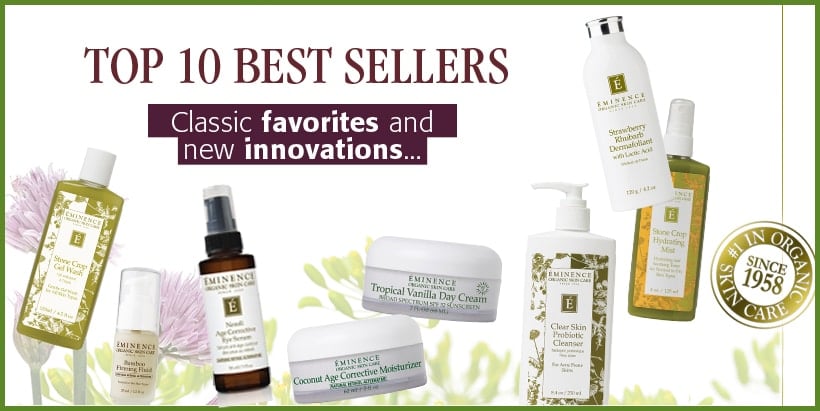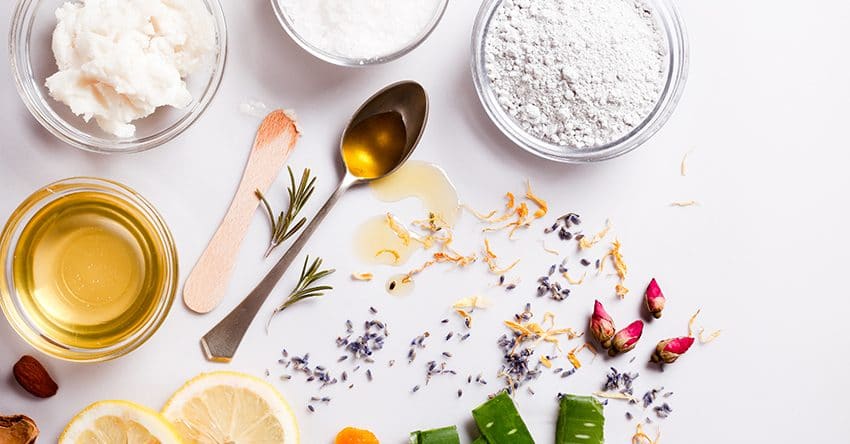In a world where sustainable skincare is more than just a trend, making eco-conscious choices in your daily beauty regimen has never been more important. Adopting a green beauty routine not only helps the planet by reducing waste and pollution, but it can also simplify your life and align your skincare with your values. At OrganicSkinCare.com, we champion eco-friendly skincare practices and strive to be a leader in sustainable beauty. Here are 10 actionable ways to make your skincare routine more eco-friendly – from product swaps to mindful habits – that will get you on the path to a zero waste beauty routine without sacrificing efficacy or enjoyment.
1. Use Brands with Packaging Recycling Programs
One of the easiest steps toward an eco-friendly skincare routine is to support brands that offer packaging take-back or recycling programs. Nearly 95% of cosmetic packaging is thrown away (much of it not accepted by curbside recycling)
so choosing companies that help you recycle empties can make a big difference. Many beauty brands now have in-store drop-offs or mail-in programs to collect used bottles and jars, aligning with a zero waste beauty philosophy.
For example, Kiehl’s skincare has collected over 7 million empty containers through its “Recycle & Be Rewarded” initiative keeping those packs out of landfills. By returning your empties to participating brands (often rewarded with discounts or free products), you support a circular system where packaging gets reused or properly recycled instead of polluting the planet. Look for brands partnered with programs like TerraCycle or those with their own recycling rewards – it’s a simple swap that greatly reduces waste.
2. Choose Refillable Skincare Products
Another impactful swap is opting for refillable beauty products whenever possible. Refillable skincare and makeup containers let you buy a bottle or jar once and purchase refills thereafter, cutting down on single-use packaging. This trend is growing across the industry – from moisturizers and serums to lipsticks and shampoos, more companies now offer refill pouches or cartridges that use far less plastic. Refillable packaging systems represent a significant shift in how we consume beauty: customers can return empty containers to be refilled or get a low-waste refill pouch, often incentivized with discounts or free return shipping
his circular economy model means you’re not tossing out a pump or jar with each purchase. Your wallet benefits too, since refills usually cost less than a full new product. To incorporate this, start with one product you frequently use – a face cream or cleanser – and switch to a brand that sells refills. Over time you’ll notice a big drop in the amount of packaging trash, aligning your routine with sustainable packaging in skincare practices.
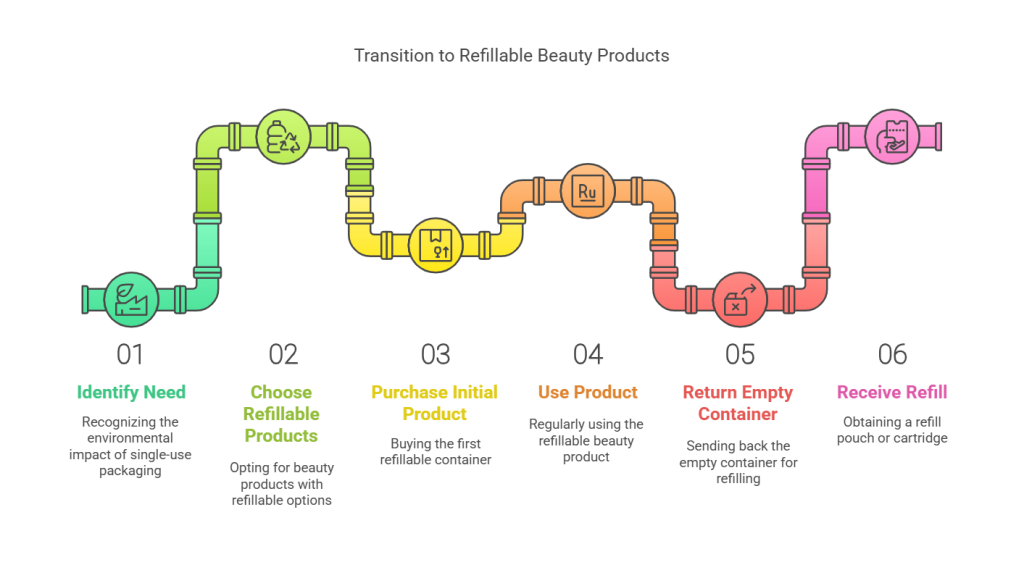
3. Opt for Multi-Use Products to Reduce Waste
Streamlining your skincare and makeup arsenal is a smart way to practice zero waste beauty. Multi-use products are designed to serve more than one purpose, meaning you buy and use fewer items overall. Fewer products mean less packaging waste, less clutter, and often a smaller carbon footprint from production and shipping. In fact, using multipurpose cosmetics is one of the easiest ways to minimize consumption and even carbon emissions – think of an eye shadow that doubles as a highlighter, or a tinted balm you can use on lips and cheeks
Instead of three separate products, one versatile item can do the job, which is a win for both your skin and the environment. For example, you might choose a moisturizer that contains SPF, a cleanser that also tones, or a makeup stick that works for eyes, lips, and cheeks. By getting creative with products that have multiple uses (or even DIY-ing a bit, like mixing your serum with foundation for a tinted moisturizer), you’ll reduce the number of bottles and tubes you consume. A streamlined, minimalist routine is not only a green beauty routine choice, it can also save you time and money.
4. Highlight Zero-Waste and Sustainably Packaged Items
When you do need to purchase new products, pay attention to how they’re packaged. Sustainable packaging in skincare has come a long way – many eco-friendly brands now use materials that are recyclable, recycled, or compostable rather than virgin plastic. Seek out products that come in glass, aluminum, or paper packaging or those that are “naked” (package-free) if possible. Brands are increasingly using sustainable materials like aluminum, bamboo, and biodegradable plant-based plastics for jars and bottles, which are often lighter to ship (reducing carbon emissions) and designed to be reused or decompose at end-of-life
Innovations in this space are exciting: for instance, some companies offer dissolvable sachets or solid bar formulations that eliminate the need for plastic packaging altogether
The beauty industry is responding to consumer pressure here – in 2022, there was a 40% year-over-year increase in products with sustainable packaging, driven by people like you demanding greener options and by new regulations
Supporting products with little to no plastic packaging directly reduces the waste your routine generates. Plus, it sends a message to the industry that eco-friendly packaging matters, encouraging even more brands to innovate in this area. When shopping, look for terms like “plastic-free,” “compostable packaging,” or “100% recyclable” on the label, and consider the packaging’s lifecycle as part of your purchasing decision.
5. Support Brands with Ethical and Sustainable Sourcing
Sustainability isn’t just about packaging but also what’s inside the bottle. Many ethical beauty brands are committed to responsible sourcing of their ingredients, ensuring that they’re harvested sustainably and that farmers or workers are treated fairly. This can mean sourcing organic ingredients that don’t use harmful pesticides, using Fair Trade shea butter or cocoa butter, ensuring no deforestation for palm oil, or supporting local communities where herbs and oils are gathered. Consumers are increasingly pushing for this level of responsibility: people prefer cosmetic brands with ethical sourcing policies, which has led to higher demand for sustainably sourced and cruelty-free products
In practice, supporting ethical sourcing might involve looking for certifications like Fairtrade, Rainforest Alliance, or RSPO (for sustainable palm oil), or buying from brands that transparently share their supply chain practices. Ethical sourcing ensures that raw materials are obtained in a way that respects the environment and the people involved – for example, by avoiding child labor in mica mining or preventing destruction of rainforests for cosmetic oils
By choosing products made with sustainably harvested botanicals and ethically sourced ingredients, you’re voting with your dollars for better practices in the beauty industry. Not only do such choices protect ecosystems and communities, they often result in higher-quality ingredients for your skin. It’s a true win-win that reflects the broader ethos of green beauty: good for you and good for the planet.
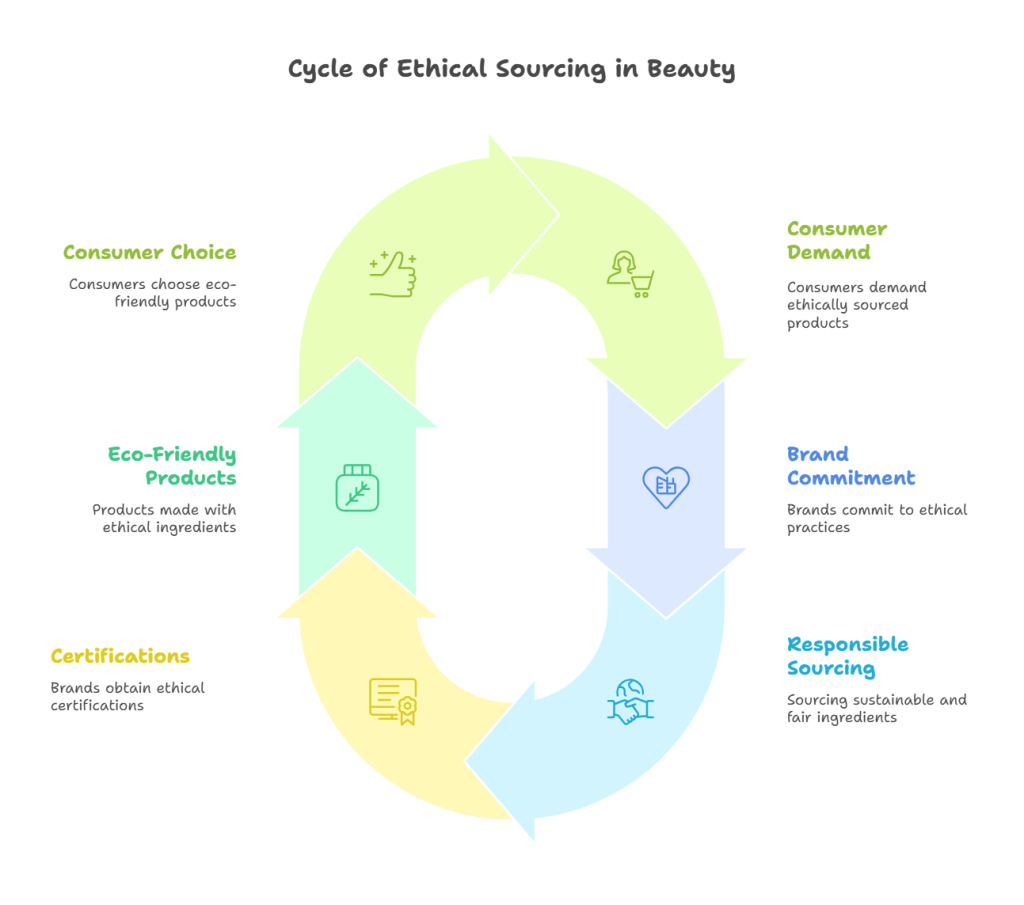
6. Avoid Single-Use Products (Makeup Wipes, Sheet Masks, etc.)
Single-use beauty products are convenient, but they generate a shocking amount of waste. Items like disposable makeup wipes, cotton rounds, and sheet masks might save a few minutes in your routine, yet they linger in the environment for decades. Take makeup wipes for example: globally, an estimated 11 billion wet wipes are thrown away each year, and each one can take up to 100 years to biodegrade
To make matters worse, most wipes contain synthetic fibers (plastic) that don’t fully break down, contributing to microplastic pollution in oceans and waterways. The good news is there are sustainable swaps for all these single-use staples. Instead of wipes, try a soft, reusable cloth or flannel with your cleanser – it works just as well to remove makeup and can be washed and used hundreds of times. Replace throwaway cotton pads with reusable cotton rounds or make your own from old T-shirts. If you enjoy sheet masks, consider switching to masks that come in jars/tubes (you apply the formula with a brush and it rinses off, without extra packaging for each use) or even DIY masks (like a simple mashed avocado or honey mask – more on DIY later). Avoiding single-use items also means saying no to things like sample sachets and minis when possible, since those tiny packets are not usually recyclable. By eliminating disposable products, you’ll significantly cut down on daily waste and eco-friendly skincare doesn’t get much easier than that – often these reusables are softer on your skin and your wallet over time.
7. Use Natural, Biodegradable Ingredients
Choosing products with natural, biodegradable ingredients is another key aspect of a sustainable skincare routine. Many conventional skincare formulas include chemicals or synthetic additives that can harm the environment once they go down the drain. For instance, plastic microbeads in exfoliating scrubs were once popular – until it became clear they were a water pollutant and toxic to marine life, leading countries like the US and UK to ban microbeads in wash-off products
Nowadays, savvy green beauty consumers opt for scrubs made with biodegradable exfoliants such as sugar, salt, coffee grounds, oatmeal, or jojoba beads. Nature has provided plenty of effective alternatives; there’s a variety of sustainable, safe exfoliators like salt, sugar, coffee, bamboo powder, crushed nutshells, and more, that buff away dead skin without any plastic
Beyond exfoliants, look for skincare that uses plant-based, organic ingredients and avoid formulas laden with silicones, petrochemicals, or other substances that persist in the environment. Biodegradable ingredients (like botanical oils, fruit extracts, etc.) break down more easily after they’ve washed off your face, meaning they’re less likely to pollute water or soil. They can also be gentler on your skin, avoiding harsh synthetic irritants. Check ingredient labels and try to avoid products with long lists of unrecognizable chemicals – often a simpler, naturally derived formula will be both eco-friendly and effective. By supporting brands that prioritize green chemistry and biodegradable content, you’re contributing to less environmental contamination and toxicity. It’s skincare that cares, in every sense.
8. Buy from Companies with Carbon-Neutral Shipping or Sustainable Production
Sustainability in beauty extends to how products are made and delivered to you. Consider the bigger picture of your skincare’s carbon footprint: the energy used in manufacturing, and the emissions from shipping products to stores or your doorstep. To make your routine truly eco-friendly, try to buy from companies with carbon-neutral shipping or other climate-conscious practices. Some brands offset the carbon emissions of shipping your order (through reforestation projects or renewable energy investments), essentially neutralizing the impact of getting the product to you. Others have overhauled production to use green energy or have achieved carbon-neutral or even carbon-negative status in their operations. Why does this matter? Because shipping and transport contribute significantly to global emissions – about 3% of worldwide greenhouse gases come from the shipping industry
and the beauty supply chain is global. Consumers are increasingly aware of this: nearly 70% of North American shoppers care about a company’s carbon footprint and want to support brands that take climate change seriously
As a result, many skincare companies now highlight eco-friendly initiatives like solar-powered factories, water-saving production processes, or carbon-neutral certified products. When shopping, look for mentions of “carbon-neutral delivery” or symbols indicating sustainable production methods. You can also reduce carbon impact by consolidating your orders (buy a few products at once rather than separate shipments) or purchasing locally made products that travel shorter distances. Supporting brands that are mindful of their environmental impact up the supply chain encourages the entire industry to move towards green beauty practices that go beyond the product itself – it’s about a sustainable approach at every step from factory to front door.
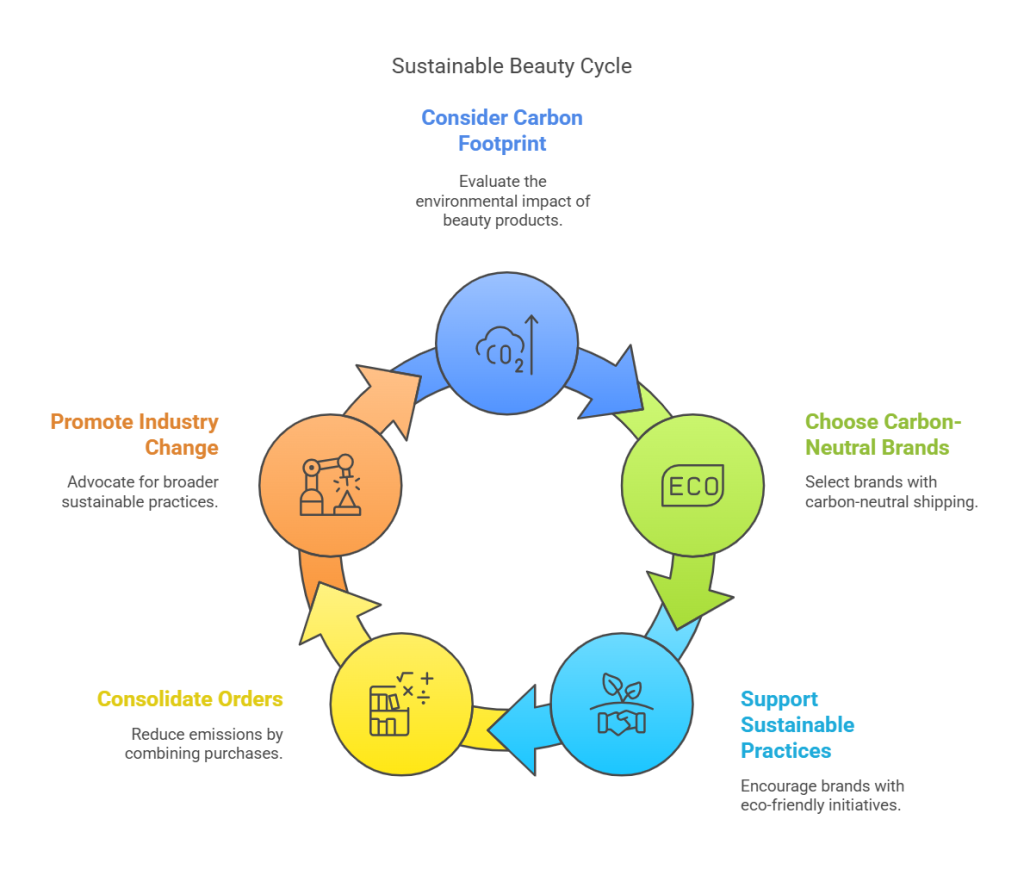
9. Make DIY Skincare Where Possible
A fun and budget-friendly way to green your routine is to do it yourself for certain skincare products. DIY skincare lets you control exactly what goes into your treatments and often uses simple kitchen ingredients – no mystery chemicals or extra packaging. In fact, making your own skincare eliminates plastic packaging and unnecessary additives found in commercial products, giving you full control of what goes onto your skin
It doesn’t have to be complicated either. Some easy DIY ideas include: mixing sugar or coffee grounds with a bit of coconut oil for a gentle body scrub, using mashed avocado or yogurt with oats for a moisturizing face mask, or applying aloe vera gel straight from the plant as a soothing hydrator. You can create a toner by diluting apple cider vinegar or using rosewater, and even craft your own lip balm with beeswax, shea butter, and oils. Every time you whip up a homemade beauty remedy, you save a container and the resources that would have gone into producing a store-bought product. Plus, you’ll often find these DIY recipes use natural, cruelty-free, vegan ingredients by default. Just be sure to patch-test anything new and make small batches (since DIY products don’t have preservatives, they won’t last as long). Not everything in your routine needs to be DIY, but replacing one or two items – say, your exfoliant or your weekly face mask – with a homemade version can significantly reduce waste and give you a fun self-care project. It’s empowering to know you can achieve great skin with ingredients from your pantry, all while living out your sustainable skincare values.
10. Choose Cruelty-Free and Vegan Skincare Options
Without addressing the ethical aspect of product testing and ingredients, no sustainable beauty routine would be complete. Cruelty-free skincare means the product and its ingredients were not tested on animals, and vegan skincare means it contains no animal-derived ingredients (like beeswax, lanolin, or carmine). Opting for cruelty-free and vegan products is kinder to animals and often correlates with brands that have broader ethical and eco-friendly commitments. Today, choosing cruelty-free is easier than ever – there is a huge variety of high-quality brands that have eliminated animal testing, and many have also removed animal by-products from their formulations. This shift is largely consumer-driven: an overwhelming majority of beauty consumers now prioritize ethical products. In one survey, 85% of consumers said they regularly use cruelty-free and vegan cosmetics, and 86% want to buy even more cruelty-free/vegan products
That shows how mainstream ethical beauty has become, pushing the industry toward humane practices. To incorporate this into your routine, look for certification logos like the Leaping Bunny, Cruelty-Free International, or PETA’s cruelty-free symbol on products – these ensure the item meets recognized standards. For vegan confirmation, you might see the Vegan Society sunflower logo or just the word “Vegan” on the label. Choosing plant-based, cruelty-free products not only spares animals from harm, but also often aligns with cleaner formulations and more sustainable sourcing (many vegan brands focus on botanical ingredients). It’s an impactful way to support ethical beauty brands that are doing the right thing. By swapping, say, your cleanser, moisturizer, or sunscreen for a cruelty-free, vegan alternative, you take a stand for compassion in beauty. And as an added bonus, these brands tend to also use greener packaging and ethical sourcing, so you’re likely accomplishing multiple sustainability goals with each switch.
Conclusion: Embrace Sustainable Beauty in Your Routine
Making your skincare routine eco-friendly is a journey of small, mindful changes that add up to a big impact. Whether you start by recycling your empties, refilling a favorite product, or choosing a cruelty-free moisturizer, each step brings you closer to a truly green beauty routine. Sustainable beauty is all about progress over perfection – even adopting a few of these tips can significantly reduce waste and make a positive difference for the planet. At OrganicSkinCare.com, we believe that caring for your skin and caring for the Earth go hand in hand. We encourage you to explore our selection of eco-conscious skincare products and resources to help you on your sustainable beauty journey. By opting for sustainable packaging, clean ingredients, and ethical brands, you not only get glowing skin but also the satisfaction of knowing you’re part of a movement toward a greener, kinder world. Ready to transform your routine into a force for good? Join us at OrganicSkinCare.com to discover more tips and find sustainable, cruelty-free skincare products that align with your values. Your skin – and the planet – will thank you.

